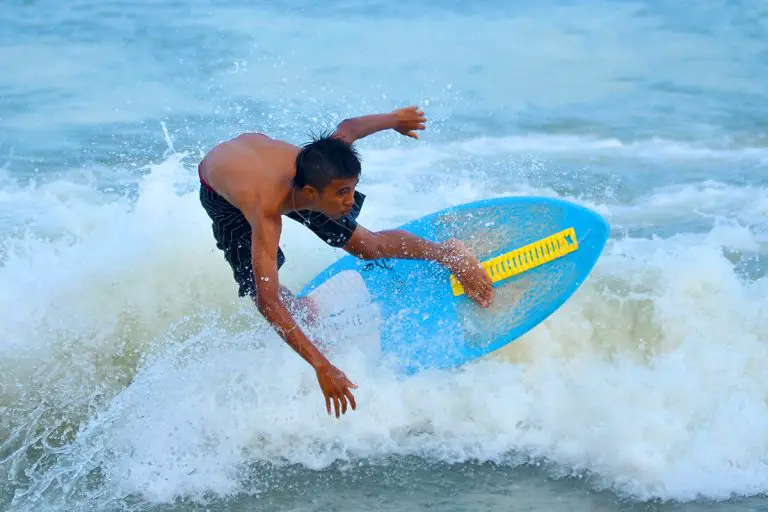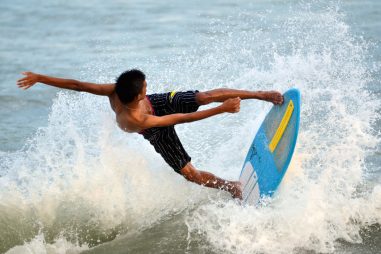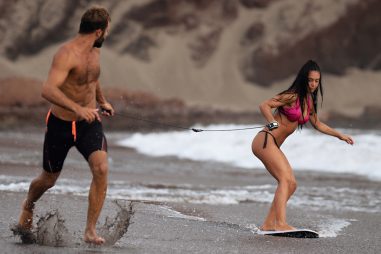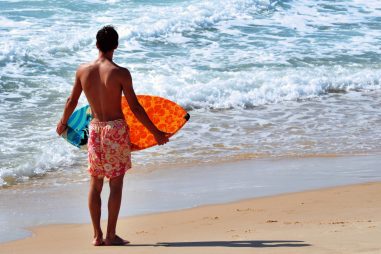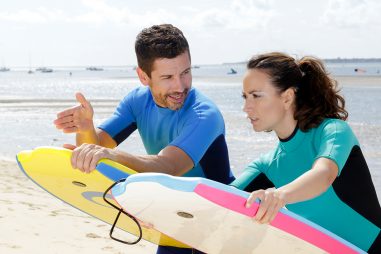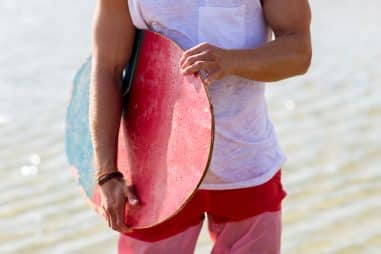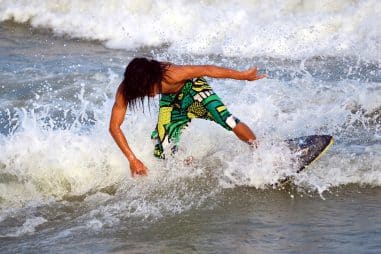A new skimboard needs to be set up before it can be used. You set it up by putting either traction pads or waxing them to keep your feet from slipping off the board. Setting up the board may be easy but catching waves on it is definitely not. It’s going to take a lot of practice before you can competently catch a wave with it. Lucky for you, we’ll be talking about not only skimming on sand but also about catching waves on the ocean and other ways of skimboarding as well.
How Do You Set Up a Skimboard?
You set up a new skimboard by first putting the traction pads on the board’s surface. The traction pads are where you place your feet when you skim so you don’t slip when riding your skimboard. It’s a matter of preference where you feel most comfortable placing your feet to feel balanced.
You may apply wax to the board’s surface after placing the pads. Although it’s not necessary if you already have traction pads, this might help to make sure you don’t slip off the board even if your feet land on the board and not on the traction pads, especially after performing tricks. Some people prefer only to wax their boards and not use traction pads at all.
How Do You Pump a Skimboard?
“Pumping” in skimboarding is an action where you push your front foot up and down the top of the skimboard. Doing this makes the skimboard stay afloat longer, especially if you encounter “dead” or flat water. This action seemingly makes the skimboard travel faster, but it slows the skimboard down in reality. However, this action keeps your board from sinking.
Since pumping is an up-and-down motion, the board will rest momentarily on top of the water. The skimboard will pop in and out of the water when this motion is repeated briskly. Doing this keeps it from sinking abruptly and will keep the board stay afloat longer and so will have it cover a longer distance.
How Do You Get on a Skimboard?
Getting on a skimboard starts with you holding the board in both hands. Your dominant hand holds the tail (end) of the board while the other hand holds the rail in the middle. Start your run holding the board in this position. Your board should be parallel to the ground before you drop it, or the edge will hit first, and you will likely not be able to get on it properly.
Remember that it is dropping and not throwing the board. Throwing the board may cause it to be destabilized and will most probably get too far ahead of you. After releasing the board, try to get at least 2-3 running steps before getting onto your board. Do not jump on the board as the impact will cause the surface tension of the water to be broken, and the board will slow down or stop altogether. Instead, aim to “run” onto the board so its momentum will not be hindered.
How Do You One-Step Drop a Skimboard?
One of the best ways to get on your board is using a one-step drop technique. You do this by dropping the board underneath or slightly out in front of you and getting on your board after taking just one step after you drop it. Basically, it’s run, drop and slide.
The preparation for the one-step drop is the same as your regular method. Hold your skimboard the same as before, run to build up momentum, drop it, take one step and quickly get on your board. You have to practice this a bit so you can get the timing right with that one quick step.
How Do You Skimboard Goofy?
Skimboarding goofy is the same as surfing goofy. Since the majority of people are right-handed, the normal stance on the skimboard or surfboard is with the dominant or right foot at the back and the left foot in front. Left-handed people would do the opposite, left foot at the back and the right foot in front. This is skimboarding goofy.
Even some right-handed riders might feel comfortable with skimboarding goofy. Skimboarding goofy can’t be said to be the wrong stance. It’s a matter of preference and how you can stay balanced on the board. So, skimboard goofy away!
Why Do You Kick Sand on a Skimboard?
Actually, you don’t kick sand ON a skimboard. Skimboarding pros kick some sand on the underside of the board. This causes the board to drop faster and flatter. This routine may seem weird, but it does have science behind it. The grains of sand add some weight to the board, which makes it drop quicker.
In the same way, the extra weight gives it a little additional heft that keeps it from wobbling when it is dropped. So, a little applied science can also help you with skimboarding.
Do Skimboards Float?
Yes, skimboards do float. Keep in mind that there are basically two types of skimboards. The first is the wooden skimboard that is used for flatland or sand skimboarding. You may be able to ride one of these out into small waves, but they are a bit heavy and will sink in larger waves. They are built for sand skimming, shred rails, and slide along the beach.
The other type is the foam-based skimboard. This is lighter and has enough buoyancy to float and skim on the water’s surface. However, they are thinner and smaller than a surfboard, so you cannot stay afloat on it the same way as on a surfboard. They are also heavy enough that they will not be tossed by the wind when you drop them.
Why Does My Skimboard Sink?
Your skimboard may sink due to several factors. First, make sure that you are not using the wrong skimboard! You might be using a wooden skimboard to skim the waves, which is not the right board for it. Assuming you have the right type of board, it might be too small for you. Choose a size that is appropriate for your height and weight.
Another reason your skimboard sinks is that you are still too far from the wave when you drop it. This means you have lost momentum when you reach the wave and thus will not have enough speed to be able to skim. Learn to read the waves, so you know when to drop your board and reduce the chances of your board sinking.
How Do You Catch Waves in Skimboarding?
First, observe the waves’ rhythm to sense when the waves are forming and breaking. Stand on the beach several meters away from the waterline. When the wave you are aiming for is still forming, begin your run towards the ocean, drop your board and ride out on the outgoing wave.
It would be best if you built up enough speed to carry you to your wave, so you have sufficient momentum to make the turn. When you reach the incoming wave, bend your knees to a crouch, stretch your arms to maintain your balance, and turn your board 180 degrees back towards the beach. You have just caught your first wave and made your first wrap!
How Do You Ride a Skimboard on a Wave?
Riding a skimboard on a wave is a tad more complicated than sand skimming. You prepare in the same way, but the first difference will be how much pressure you apply to your board’s nose. In wave skimming, you put a little less pressure on the nose, so it stays above the water. This keeps you from nose-diving and losing speed.
Then you have to decide how steep or how flat your angle of attack should depend on the incoming wave. The bigger the wave, the steeper the angle. By this time, you should already know how big or small the waves are, but you should continue to watch them for any sudden changes. You should be aiming for its highest point, so you get the maximum ride out of it.
Can You Catch Waves on a Wood Skimboard?
Wooden skimboards are not intended for surfing waves since they don’t have the buoyancy for them. They sink faster, and that makes them unsuitable for catching waves. These are not high-performance boards and are not used in competitions.
However, they are affordable and good for learning to skim on wet sand by beginners. Wooden boards can be classified as a learner’s board and a good piece of equipment for learning skimboarding. This board is also suitable for skimming and doing tricks on the sand for the more advanced surfers.
How Do You Stand on a Skimboard?
Your feet should be about shoulder-width apart. Your back foot’s position should be 50-75mm away from the tail of the board. You place your front foot where it feels comfortable and natural for you. Keep your center of gravity low.
Your knees have to be slightly bent so you can adjust your balance as you skim. This stance holds true whether you skim regular or goofy. You may adjust your footing as needed when you perform tricks and maneuvers. What’s important is you feel balanced on your board throughout your skim.
How Do You Steer a Skimboard?
You steer your skimboard with your feet mainly by leaning towards the direction you want to go. This is why you need to be well-balanced on the board as well as having a good grip on the board with your feet. If you don’t have traction pads on your board, make sure it is waxed often, so your feet do not slip.
If you are a beginner, you learn to steer by turning on your rail first. Turning on the board’s tail is for more advanced riders. You steer your board by leaning into the wave, slightly dipping your head and shoulder towards the direction you are going. The position and weight distribution of your body on the board are very important in guiding it.
How Do You Turn on a Skimboard?
Turning on a skimboard can be done by a simple move. You can turn left or right by simply using your toes and heels. While standing on your board with your feet parallel to each other, shift your weight in the direction you want to go. You shift your weight on your toes if you want to turn right and, on your heels, if you want to turn left.
Make sure you turn in relatively deep water since the edge of your board may dig into the sand if you are in shallow water. You don’t want to do that. You will get thrown off your board and may get injured. Worse, you will damage your board.
How Do You Go Further on a Skimboard?
Skimboarders ask one question: How can they go further since they are limited by their run’s speed and the wave quality. Actually, there is a way for you to join up with the incoming waves further out so you can have a longer ride.
You can do a water drop instead of dropping your board in the sand. With your run-out, drop your board as far out as you can in the incoming wave without it sinking. Then you turn your board sideways, so you are facing the wave instead of having the board’s nose facing it. This move is known as side-planing or side-slipping. Doing this allows you to maintain your speed or at least not slow you down immediately. With this move, you can meet the waves that are a little further away, and you get to enjoy a prolonged ride.
How Do You Skimboard on Sand?
All skimboarders start off on the sand, as this is where it’s easiest to learn. Let’s go through the steps of learning to skimboard on the sand. The first step is to choose the right beach for it. Avoid a beach with mushy or gooey sand as your board will get stuck on it. The beach must be free of obstacles such as shells or rocks. It should have good sand consistency, plus a gradual slope would be ideal, so the water doesn’t run off immediately.
You start sand skimming the same way you do it for wave skimming; run, drop and jump. You can also do tricks on wet sand similar to what you can do with skateboards. You can jump over natural or artificial obstacles on the beach. However, you have to be careful as skimming on hard-packed sand will hurt if you slip off your board.
How Do You Skimboard in the Ocean?
Wave skimming is skimboarding from the beach into the wave and then riding the wave back to the beach. The boards used for this are different from wooden boards. They are longer and wider and, like surfboards, are usually made of polyester or epoxy. A wave skimboard is also more buoyant than the wooden board used for sand skimming as it has to carry you through deeper water to reach waves a bit farther from the beach.
Assume the ready position while observing the waves and time it when to start your run. The faster you run, the more momentum you will have, and you can go further on your slide. You can wait until after the shore break and start your run when the wash recedes from the shore. Or you can start your run when the next wave is incoming, dropping your board on the shallow water and hopefully get on the wave’s peak and perform a 180-degree turn to ride the wave back to the shore. Congratulations! You have just performed your first backside wrap!
How Do You Skimboard in Deep Water?
Skimboarding in deep water is tricky. Unlike the surfboard, a skimboard is not that buoyant. It is thinner and smaller, not really built for long rides. The only way you can use it in deep water is for you to get transported to the starting point and ride it from there. The conditions must also be right so you can ride the waves safely and properly.
You will start off by riding a jet ski or a boat to where the waves form. After getting a running, or rather a skimming, start with the help of the transport, you will build up sufficient speed to be released from being towed. You then ride the momentum of the wave to get to the shore break. The waves have to be of suitable speed so you can stay on top of it and not sink.
How Do You Flatland a Skimboard?
Remember that the wooden skimboard is designed to be used only on surfaces with very shallow water as this will not float. We imagine skimming along the shoreline with smooth, very shallow water when we think of flatland skimboarding. However, flatland skimboarding, also known as inland skimboarding, has been performed by extreme athletes to skim on various surfaces as well.
You can enjoy flatland skimming anywhere there is a reasonably level surface, enough space to run and slide a shallow enough water to provide a slick surface, and a touch of masochism as this will definitely hurt if done wrong. It can be done in flooded roads, flooded grassy plains such as golf courses, a long enough wetted-down tarp, and riverbanks. Obstacles may even be set up to make the course more challenging. Ramps, logs, pipes, and similar hurdles are all fair game as course barriers.
How Do You Ride a Wooden Skimboard?
Wooden skimboards are the best type of board for flatland skimboarding. It is shorter and rounder than wave skimboards but much thinner and heavier. This is designed that way to perform tricks better and handle rails and other obstacles easily.
Think of a wooden skimboard as a skateboard without wheels. You can use it on wet grass, snow, riverbanks, shallow canals, or even a flooded road. As long as it’s slick, smooth, and level, you can probably skim on it if you don’t mind wrecking an old board now and then. Extreme skimboarders have been known to skim urban water features such as fountains, shallow canals, and even stairs with running water. You can always find skimming prospects if you look for it hard enough.
How Do You Skimboard Behind a Boat?
Skimboarding behind a boat, also known as skim boating, can be performed similarly to wakeboarding, where the surfer is towed behind a boat. If you are starting in shallow water or on the sand, simply take hold of the tow rope while already mounted on the board and have the boat draw you into the water. When starting in deeper water, position the skimboard vertically with its nose facing the boat. Place your feet on the board per your normal stance, have the boat move forward slowly, and turn the board into a skimming position (with your feet in place). Make sure you have sufficient speed before turning the board, so the skimboard does not sink. Remember that the board will not float if it is not moving.
Another way to skimboard behind a boat is how extreme surfing athletes do it. In this setup, they don’t have a rope to tow them. Instead, they use the wake of the boat to draw them behind it. The forward momentum of the boat’s wake, if strong enough, will pull them behind the boat.
How Do You Skimboard Properly?
To be able to skimboard properly, you must have the basics down pat. It may be easy to learn, but it will definitely take time and a lot of practice before you can be reasonably skilled in it. It will help a lot if you don’t have to unlearn bad habits picked up when you start to skimboard. Loke driving a car, start in the lowest gear first and increase your speed as you become more skillful and you gain more confidence.
You should also have the right equipment to skim properly. Your board must be suited to your weight and height. You must also use the right type of board if you are skimming on sand or wave. Wear a wetsuit if you are in a colder climate. You can’t expect to do well if you are freezing. Take your time to learn, and don’t rush into performing tricks immediately. Again, to skimboard properly, you need time, patience, and practicing the right way consistently. Before you know it, you’re on your way to becoming a more proficient skimboarder!

